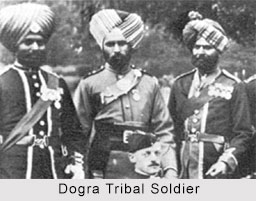 Decline of Princely State of Jammu and Kashmir came with the end of the rule of British Government of Modern India. On 15th August 1947, the British gave the freedom to India and Pakistan and rise in the dominion in South Asia. In the Independence Act, India and Pakistan were both able to capture the princely states of India.
Decline of Princely State of Jammu and Kashmir came with the end of the rule of British Government of Modern India. On 15th August 1947, the British gave the freedom to India and Pakistan and rise in the dominion in South Asia. In the Independence Act, India and Pakistan were both able to capture the princely states of India.
Freedom of India and Decline of Princely State of Jammu and Kashmir
In 1947, Britain gave up its rule of India, with the Indian Independence Act and the Transfer of Power. The Indian Independence Act divided British India into two independent states, the Dominion of Pakistan and Dominion of India. According to the Act, "the suzerainty of His Majesty over the Indian States lapses, and with it, all treaties and agreements in force at the date of the passing of this Act between His Majesty and the rulers of Indian States." So each of the princely states was now free to join India or Pakistan or to remain independent. Most of the princes acceded to one or the other of the two nations. Princely State of Jammu and Kashmir came in the hands of Indian Independent Government governed by Pandit Jawaharlal Nehru and C. Raja Gopalachari after the transferring all the soldiers and the powers by Maharaja Hari Singh, when the Independent Pakistan attacked India with the method of civil war by the Muslim tribal of Kashmir against the Hindus.
Majority in Religion
Jammu and Kashmir had a Muslim majority but was ruled by a Hindu Rajput Raja. On 2nd October 1947, the Working Committee of the National Conference met under Sheikh Mohammad Abdullah`s presidency and took the decision to support the accession of the State to India. The decision of the Working Committee was conveyed to Indian leader Nehru by another Kashmiri, Dawarka Nath Kachru, the Secretary General of the All India States Peoples` Conference, who attended the Working Committee meeting as an observer.
Desire of Maharaja Hari Singh to be Independent
Maharaja Hari Singh wanted his state to remain independent, joining neither Pakistan nor India. For this reason, he offered a standstill agreement to both India and Pakistan. India refused the offer but Pakistan accepted it. The Maharaja was advised by Mehr Chand Mahajan, who later was his Prime Minister, that a landlocked country such as Kashmir would be soon engulfed by foreign powers such as Russia, Britain, United States of America and China.
Rebellion in Princely State of Jammu and Kashmir
The Gilgit Scouts staged a rebellion in the Northern Areas under British command. As a result, this region became effectively a part of Pakistan (and has since been administered by Pakistan). Subsequently Kabaili tribesmen (Mehsuds and Afridis) from the Northwest Frontier Province invaded Kashmir proper. The Pakistan Army`s British chiefs, Sir Frank Messervy and Douglas Gracey, refused to involve the armed forces. With independence no longer an option, the Maharaja Hari Singh turned to India, requesting troops to safeguard Kashmir. Although Nehru was ready to send troops, Governor-General Mountbatten advised the Maharaja Hari Singh to accede to India before India would send its troops. The Kabaili tribesmen spread into Kashmir. So the Maharaja Hari Singh signed the Instrument of Accession to the Dominion of India on 26th October 1947.
Sheikh Mohammad Abdullah had already reached Delhi on 25th October to persuade Nehru to lose no time in accepting the accession and dispatching Indian troops to the State.
Instrument of Accession to the Dominion of India
The Instrument of Accession to the Dominion of India was accepted by the Governor-General the next day, 27th October 1947. With the signature of the Maharaja Hari Singh and the acceptance by the Governor-General, the princely state of Jammu and Kashmir became a part of the Dominion of India. Indian troops landed at Srinagar airport in Kashmir on 27th October and secured the airport before proceeding to evict the invaders from the Kashmir Valley. Thus with the Instrument of Accession to the Dominion of India, the Princely State of Jammu and Kashmir declined.
From Princely State of Jammu and Kashmir to Jammu and Kashmir
Princely State of Jammu and Kashmir thus came under Indian suzerainty on 27th October 1947, with a portion of it having passed to Pakistan`s control. The Maharaja Hari Singh appointed Sheikh Abdullah as the Prime Minister and, in 1948, appointed his son Karan Singh as the Prince Regent to act on his behalf. Jammu and Kashmir operated as a princely state under Indian control till 1952, when the Constitution of India came into effect, abolishing monarchies. Karan Singh then accepted the post of Sadar-i-Riyasat or the Constitutional Head of State in Jammu and Kashmir.
Related Articles
Modern History of India
British Empire in India
Princely States of India
Princely State of Jammu and Kashmir
Jammu and Kashmir
British East India Company



















